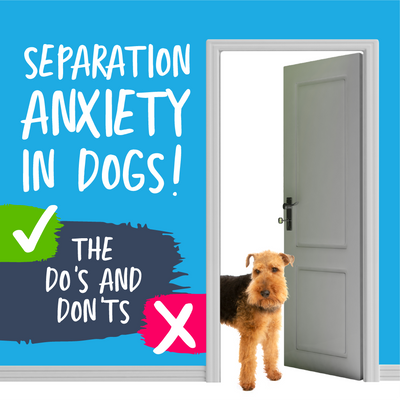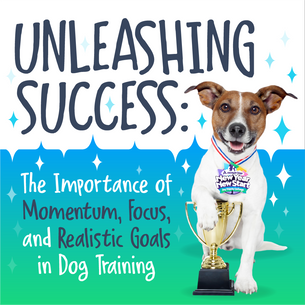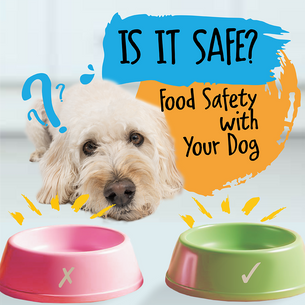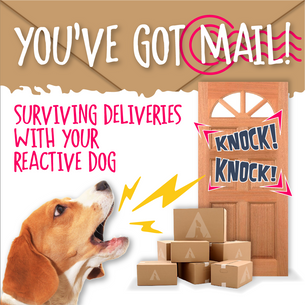Does your dog struggle with spending time away from you?
Living with a dog who finds it hard to spend any time alone can be extremely challenging.
However much you love your dog and want the very best for them, you need to be able to do things that don’t involve them. There are occasions when you are going to need your dog to be calm and content with spending time away from you.
Dogs don’t come knowing that being left alone for periods of time is a good deal! While some will embrace this pretty easily, for others it’s a real struggle. In fact, for some dogs, it is truly terrifying.
The reality is that not every dog naturally wants to spend time alone - or has the skills to be able to do so.
If you’re having a hard time helping your dog learn to spend time alone, we want to tell you three very important things:
- You are not alone.
- Teaching your dog to be content with spending time away from you - both when you’re at home and when you go out - will set them up for the very best success.
- Your dog can learn the skills to embrace and even enjoy spending periods of the day separated from you.
Whether your dog already struggles with separation anxiety, or you’re looking for ways to set your dog up for ultimate success, keep reading to discover how you can skill them up to be separation solid!
Before we delve into the dos and don'ts that are going to allow you to manage your dog’s separation anxiety, let’s look at what separation anxiety actually is.
What does separation anxiety look like?
Does your dog show a change in behaviour when you’re not at home, or when separated from you by a physical barrier? Can you go to the toilet in peace, or does your dog cry when you leave them or insist on following you to the bathroom?
You may not even realise your dog has separation struggles because the behaviours happen in your absence.
Let’s start by looking at the most common behaviours which might be telling you that your pup or dog may not be happy being away from you.
- Unable to eat or drink in your absence
- Destructive behaviour
- Following you around the home
- Barking or crying while you’re gone
- Pacing
- Whining when you leave and greeting you excessively when you come home
Why might your dog struggle with separation anxiety?
The Bucket
Just the same way as we do, dogs have stress thresholds. We like to represent this as a bucket. Your dog’s bucket might be big or small. The hole in the bottom of the bucket which allows it to empty might be big or small.
Many things pay into your dog’s bucket. Excitement, scary things, novelty, pain, and itchiness are just some of the common bucket-fillers.
Some dogs have very big buckets that fill slowly and empty easily. Others have much smaller buckets which fill much more quickly and overflow much more easily.
If your dog always has a full stress bucket, their ability to cope with things they find hard – including being left alone – will be impacted. At the same time, if your dog is genuinely fearful of separation, being left (and even the thought of being left) will also be filling that stress bucket.
THE FIRST 10 MINUTES
Typically, dogs who display separation anxiety will do so within the first 10 minutes of being left alone. This is really important to help you differentiate separation anxiety from behaviours caused by boredom or lack of enrichment while you’re gone.
Have you ever filmed your dog when you’re not home? If not, we challenge you to set up a camera and see what happens within the first 10 minutes of your absence.
The Shape of Your Dog's Brain
As well as a full bucket, your dog might be missing some of the key skills that would help them relax in your absence rather than getting worried or stressed being left alone.
Calmness
Calmness is King! Calmness should ideally be your dog’s default state. Can your dog remain relaxed despite sudden changes in the environment? Are they able to settle and relax? A dog who has true value for calmness will always make the very best choices.
Discover How to Teach Your Dog to be CALM and SETTLED! so they can make the very best choices, when you’re at home and when they need to be left alone.
Optimism
Just like humans, some dogs are born optimists while others are more pessimistic by nature. If your dog has a pessimistic view of the world, anything new, different, or challenging will trigger feelings of fear and uncertainty. This will include being left alone.
Does your dog need more confidence and optimism around novel things? By playing games that focus on building and growing optimism, you can make your dog’s outlook more optimistic, and guard against separation anxiety. As a concept, Optimism Rocks!
Independence
Independence determines whether your dog sees value in spending time away from you and is comfortable doing so.
Tolerance of Frustration
Frustration is the emotion that comes about when something you expect to happen doesn’t happen, or doesn’t happen immediately. Tolerance of Frustration dictates how well your dog copes when they can’t have immediate access to something they want (toys, food, a dog in the distance, YOU!)
Are all your dog’s needs met?
If your dog is hungry, thirsty, too warm or cold, or needs a toilet break, it’s going to be very difficult for them to settle. That’s before you even add in the aspect of being alone!
To set your dog up for success you need to make sure that each of your dog’s needs is addressed before you leave them alone and expect them to be able to settle.
The independence required for calm, settled behaviour away from you can be grown and developed over time – but it needs as its basis a foundation of security.
Why might your dog struggle with separation anxiety when you’re at home?
One of the things that can be most challenging to understand and to know how to deal with is a dog who struggles to be separated from you if you are at home - especially if they seem to be OK when you go out.
Why might your dog struggle when they know you are there but they can’t get to you?
Dogs are very quick to learn that the presence of their humans is important. If your dog thinks they should always have access to you whenever you are present in the house, this very quickly becomes part of their blueprint of the world. Any other scenario is incompatible with this blueprint.
It’s easy to reinforce this. You want to spend time with your dog when you’re at home. They’re part of the family! Perhaps more crucially, if your presence is important, then your absence is also important.
One of the biggest gifts you can give your dog is teaching them that your presence at home doesn’t automatically mean they have access to you. We’ll dive into this a little more below.
Separation anxiety is more than just anxiety
It’s important to recognise that the word “anxiety” can understate how much of a struggle this can be for some dogs. The reality is that for many dogs, separation causes FEAR.
With this understanding, let’s dive into some practical strategies to help your dog overcome this struggle.
The importance of training FOR the situation when it comes to separation anxiety
If your dog is anxious or fearful of being left alone, their brain is currently not shaped in a way that is compatible with that scenario. Leaving your dog home alone and hoping they will get used to it over time is very unlikely to work, and may add to your dog’s separation anxiety.
Working on separation struggles doesn’t start with leaving the house for 2 minutes, or 5 minutes and coming back.
You might have been told that the best approach is to pop your dog in a crate, close all the doors and leave them to “cry it out”. This is what we would call training in the situation!
Leaving your dog distressed is not the best way to teach them that you are a team and that you are there to meet their needs.
It also doesn’t work!
Letting your dog cry actually builds their resilience. They learn that the more persistent they are, the more likely they will (eventually) get what they want. By letting your dog cry and not meeting their needs, you are hardwiring them for anxiety.
Instead, it is important to set up a training plan that does not allow your dog to rehearse that emotional state. You need to put the concepts in place - those building blocks that will empower your dog to be happy being left alone, first when you are in the house, and then when you go out.
Separation Anxiety: The Dos
Separation Anxiety DO Number 1: Teach Presence Doesn't Mean Access
If your dog has constant access to you whenever you’re at home, logically they learn that your presence is important. The next logical step in your dog’s understanding of the world is that your absence is also important.
For a dog struggling with separation anxiety, this can exacerbate their anxiety. Teach your dog that your presence doesn't always lead to playtime or interaction.
You can help your dog to learn this important concept by using what we call a “gated community”. That might be a combination of baby gates, puppy pens, closed doors and crates – areas and rooms of your house where your dog can hang out independently of you and without constantly having direct access to you.
The key is teaching your dog this is OK and that they are able to be calm and relaxed when they don’t have access to you.
Check out our top tips for building value in the crate and key strategies for growing your dog’s love of crates and boundaries.
When you arrive home, resist the urge to engage with your dog immediately. Instead, spend a few minutes doing ordinary tasks like making a drink, checking emails, or making a phone call. This helps your dog understand that your presence doesn't always result in exciting activities.
Separation Anxiety DO Number 2: The Calmness Triad
Encouraging calmness is crucial in managing separation anxiety. Before expecting your dog to remain calm when left alone, establish a foundation of calmness in your presence. Reward calm behaviour, and play games that grow this rockstar concept.
If your dog is struggling with calmness, our FREE Calm eBook is full of top tips and strategies that will help to grow your dog’s calmness.
By instilling a sense of calmness around you, your dog will be better equipped to handle periods of separation.
Separation Anxiety DO Number 3: Use Gated Communities
Creating a designated space for your dog using baby gates, puppy pens, closed doors, or a crate is an excellent strategy for reducing separation anxiety.
Gradually introduce your dog to this "gated community" and provide them with a chew or calming mat to keep them occupied. Stay close to the area initially, and gradually increase the distance. This teaches your dog that being away from you can be a positive experience.
Separation Anxiety DO Number 4: Purposeless Movement
Dogs are observant creatures, and they may learn to associate particular movements with specific actions, such as leaving the house. To counter this association, engage in purposeless movements throughout the day.
Walk around the house without a particular goal or agenda, making your movements less significant to your dog. This helps reduce arousal triggered by your actions - and means your dog’s bucket isn’t being filled with the anticipation of being left alone.
Separation Anxiety DO Number 5: Play Boundary Games
Boundary games are an excellent way to teach your dog to stay calmly in a specific area until released. This helps your dog understand the value of staying in a space without following you around.
Play Boundary Games while you cook, clean, or engage in other activities. Gradually increase the distance from your dog while they remain calm in their designated area.
If your dog is new to Boundary Games, check out the Boundaries Rock episode of our podcast and download your free copy of our Boundary Games eBook.
Separation Anxiety DO Number 6: Give The Gift of Optimism
Building your dog's confidence and optimism is crucial for tackling separation anxiety. Expose your dog to new and novel situations in a positive and reassuring manner.
Gradually introduce them to new environments, people, and experiences, rewarding them for their bravery and curiosity. This helps your dog associate novelty with positive outcomes and reduces anxiety.
Separation Anxiety: The Don’ts
Separation Anxiety DON’T Number 1: Leaving Your Dog Unprepared
Avoid leaving your dog alone for extended periods before they are ready to handle it. Rushing into separation training without building a solid foundation can lead to heightened anxiety.
Build your dog’s skills while you’re at home first. Start with short periods of separation while you’re close by, and gradually increase the distance and duration as your dog becomes more comfortable.
Separation Anxiety DON’T Number 2: Neglecting Physical and Emotional Needs
A full stress bucket can contribute to separation anxiety. Address any underlying health issues, such as pain, itchiness, or gastrointestinal problems. Additionally, fulfil your dog's physical and emotional needs through regular exercise, mental stimulation, and engaging activities.
Separation Anxiety DON’T Number 3: Rushing Into In-Situation Training
Training in the situation, such as leaving the house for short periods, should be approached with caution. Begin with building a strong foundation using the dos mentioned above. Only when your dog is more comfortable with separation-related concepts should you start in-situation training.
Separation Solid!
Dealing with separation anxiety requires patience, consistency, and understanding. By following the dos and avoiding the don'ts, you can help your dog build confidence, cope with separation, and enjoy a happier and more relaxed life.
Remember that each dog is unique, so it's essential to tailor your approach to their individual needs. If the anxiety persists or worsens, seeking professional help from a certified dog trainer or behaviourist can provide valuable guidance and support.
With time, dedication, and positive reinforcement, you can help your dog overcome separation anxiety and enjoy a harmonious relationship together.




